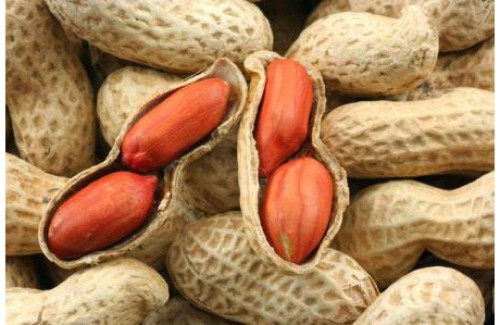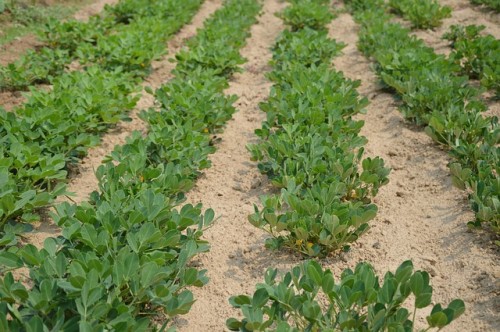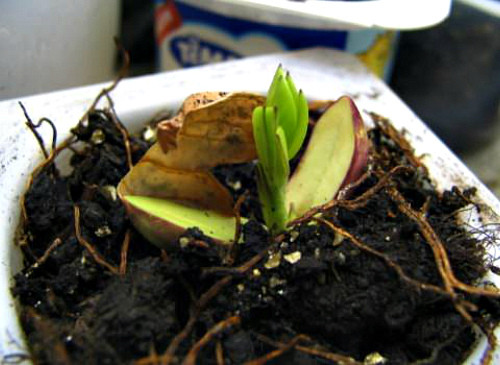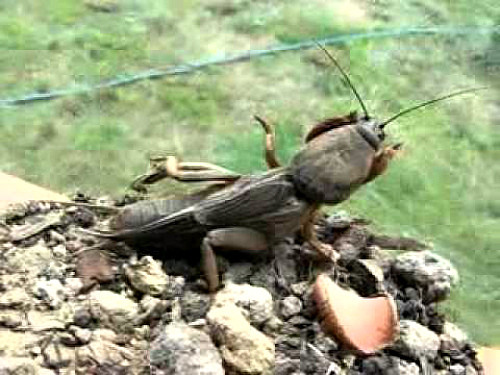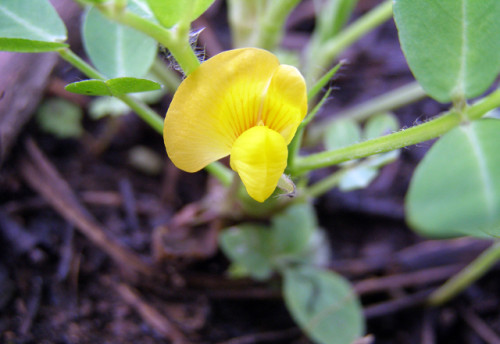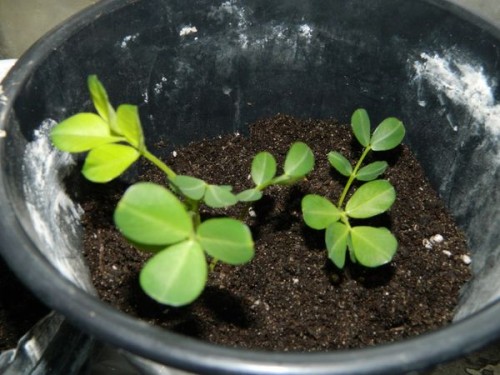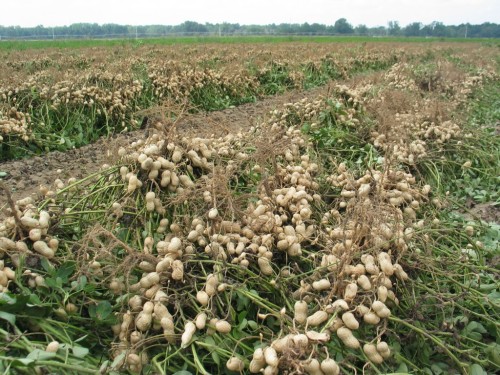Many dacities love to experiment with the cultivation of new cultures. It's nice to surprise guests, putting something unusual on the table, proudly declare: "I grown on the garden." If you are from among these passionate people, try to grow peanuts. By the way, this is not such a difficult one task, and in our article we will introduce you in detail with this culture and agrotechnology of cultivation.
Content
It turns out that this is not a nut at all
Although peanuts and call nuts, but in fact he is a relative of ordinary beans, because Refers to the same family - legumes. This plant looks like this:
- Kostik has a height of 0.5-0.6 m.
- Stem - branched.
- Leaves - parsley, dark green.
- Flowers are yellow, small, sometimes their number comes up to 2 hundred. The lower gradually falling to the ground, penetrate into it and turn into a bob there, which is called nut. Each shell is formed from 1 to 4 seeds of light pink. 30-70 nuts are collected from one bustle.
About the benefits of peanuts
Of course, peanuts are delicious, especially toasted, but it is not all his advantages, because it contains that it is necessary for the body:
- carbohydrates;
- proteins;
- fats;
- linolenic acid, vitamins B, E, if the beans are recycled on the oil.
And from these tasty nuts make peanutas, which in its energy value is the same as meat, but useful because of the content of folic acid in it.
We grow peanuts
To grow in our temperate climate this plant of the legume family, you should buy seeds of the following varieties:
- Krasnodar 13;
- Krasnodar 14;
- Staplek;
- Valencia 433;
- Klinsky.
Be carefull: Check that you do not sell processed or roasted beans, otherwise spend money, time, and shoots never wait.
To grow peanuts at home, you need to know what is needed for its growth.
Conditions for the development of the plant
- Since nuts can develop exclusively in Earth, a good crop is possible only in loose black earth, sampling or neutral soil. It is necessary for magnesium and potassium, as well as humus in large quantities. Pluming bushes up to 3 times per season, we will increase the number of wounds.
- Since the birthplace of Peanut is South America, where it grows as a perennial, the second condition for its successful development is the temperature. Optimal - 20-27 degrees C, and as soon as it rises above +30 or drops below +15 - bushes cease to grow.
- The third condition of successful cultivation is good illumination. It is unacceptable for near plants that shadow this culture.
- It is important that the Girling, on which this representative of the legumes is planted, was well ventilated.
- When peanuts blooms and the formation of underground beans occurs, it requires a constant presence of moisture, but not stagnant water. In September, when the seeds ripen, excessive moisture can slow down this process.
- The plant develops well on the beds, where they grown cabbage, cucumbers, potatoes, tomatoes, cereals, but in no case are not beans, peas, i.e. His relatives are legumes. But after the peanuts, any cultures feel well in bed.
- If you are going to grow it in a lot of quantities and get oil from it, then know that the color of the peanut depends on the soil. From beans grown on light soil, oil will be bright, and on dark - darker.
Important: If the conditions necessary for the growth and development of peanuts are broken, the plant begins to hurt - spots appear on the leaves, which indicates the presence of root rot.
How to grow peanuts: ways
Earthwoods are grown through seedlings and sowing in open ground. How the planting material should take grains collected not more than 2 - 3 years ago, because Next they lose their germination. In any case, the seeds first should be germinated. This is done at the end of April:
- We lower the seeds into a weak manganese solution for disinfection.
- We rinse and soak for germination. After 10 days, sprouts will appear.
- We boost the sprouted seeds, withsting within 2-3 days indoors at a temperature of about +3 degrees in the bright time of the day, and at night we carry them into such a place where the temperature is room.
From the sprouted seeds grow seedlings or sow them to the garden. First, consider how to grow peanuts sediate. So:
- fill the cups with light ground in the first days of April;
- weaken the seeds into the ground centimeter at 3;
- we place the cups on the sunny windowsill;
- we water moderately;
- we, meanwhile, the Grokery - are driving it and remove weeds;
- looking out the plants in early June with an interval of 15 - 20 cm from each other and 0.6 - 0.7 m row from the row.
If they decided to plant peanuts immediately into the ground, then as soon as the constant air temperature is set at least 20 degrees C, and the land at a depth of 10 cm warms up to 15 degrees with, proceed to sowing sprouted seeds. The landing scheme is identical to the one that is used when disembarking seedlings, and the depth is 60 - 80 mm. Singing sprouted seeds into the ground is not only in order to see the harvest faster, but also to protect them from being damaged by the Medveda.
Good to know: on the shell in which there are nuts, there are many useful microscopic mushrooms, so it is crushed and thrown into the ground when landing.
Faced with Medveda
To destroy the Medvedka, make a bait:
- we collect cleaning, grain;
- cheat on the garden;
- we take a piece of rubberoid and cover;
- fall on top of the vegetable garbage, manure or humus;
- periodically, we look at the bait and collect the polar.
For your information: as soon as germs appear, it is necessary to protect them from birds, as the sprouts can completely destroy crows and thrills.
Plugging, stealing peanuts
An important component of a good crop is an extracting, which is held several times per season:
- Before the plants bloom, plunge bushes at a height of 50 to 70 mm.
- After 10 days after it blooms.
- Regularly at intervals of 10 days, gradually reducing the distance between the roots (ginoforami) formed after flowering, and soil. Last hilling performed in early August.
Three times during the season and when it began to form true leaves, buds tie, then the fruit, we make fertilizers per 1 sq.m.:
- nitrogen - 0.45 to 0.6 kg;
- phosphorus - from 0.5 to 0.6 kg;
- potassium - 0.45 kg, but only in sandy loam soil.
Peanuts on a bed of warm
Wondering how to grow peanuts in the country, and consider the option of a warm bed. It is better to prepare in the autumn or very early spring in case of emergency:
- Select the place, and proceed to the digging of the trench to a depth of bayonet spade. The optimum width of 1 m, and the length of what you want.
- Storage of the upper layer of soil on one side of the trench, and the bottom - on the other.
- The bottom littered with plant remains, sprinkle them with earth. Top place half overrotten compost.
- Sheltering all the top layer of soil.
If the soil is healthy, the 60 days will be filled with a warm bed nutrient soil suitable for growing peanuts.
Peanuts grow in the greenhouse
In the greenhouse, peanuts comfortable, especially when grown in tandem with his tomatoes, provided that the latter are located is not very thick, to peanut still incoming light. Legumes share with tomatoes nitrogen, and often do not need to spud bushes - 2 times in June and that's enough. By September, the harvest will be ready already.
How to grow peanuts at home on a window sill
Having grown seedlings of peanut can be a few plants to leave the house, and then to harvest right on the window sill. Make it simple:
- Take a container and fill it with soil, mixed it with humus and sand.
- Planted in it and place the plant in a bright place, it follows that there are no drafts.
- We are waiting until the flower, and from there develop a bean. It is important that runners are not hanging outside the container, or tie a fetus does not receive development.
- Regularly watered, loosen the soil slightly.
- Fruit is harvested when the bush cease to grow, and the leaves begin to turn yellow.
Harvest
Peanuts can not withstand even minor frosts, so cleaning should be performed prior to their occurrence. Wherein:
- sort peanuts to mature and ripened;
- we throw very small;
- pushes in a ventilated, dry room to finish drying;
- store in fabric bags;
- husks as needed.
If we ensured proper care, we can count on a crop from 100 to 150 g of dry grains with 1 square meters. m, and even higher.
Check video how to grow peanuts:


